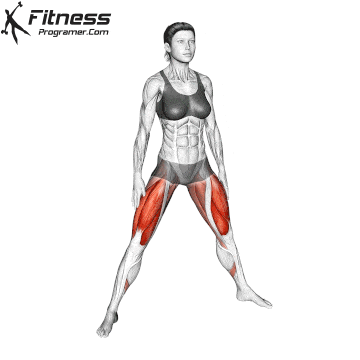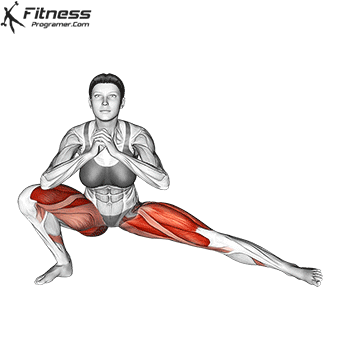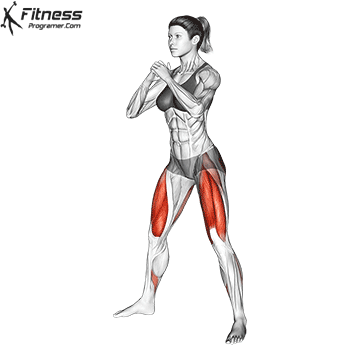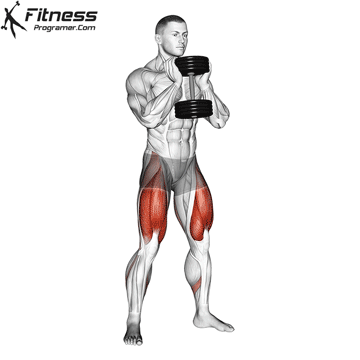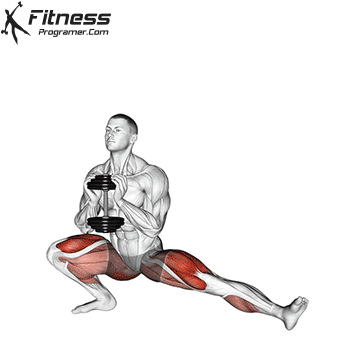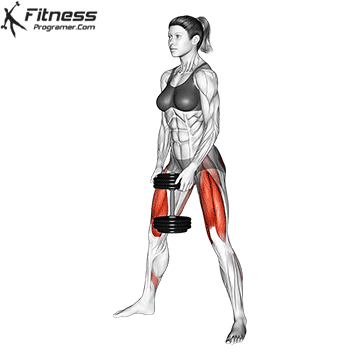Overview
The Plie Dumbbell Squat is a wide-stance squat variation performed while holding a dumbbell, which adds resistance and stability. This positioning increases muscle activation, especially in the inner thighs and glutes, while also engaging the core to maintain balance and posture. Because of its focus on the adductors and core, it’s an ideal exercise for strength, hypertrophy, and mobility-based routines.
How to perform Plie Dumbbell Squat
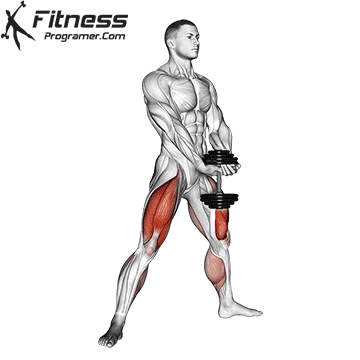
Stand with your feet wider than shoulder-width, turning your toes outward at a 30 to 45-degree angle.
Hold a dumbbell vertically with both hands either in a goblet position at your chest or between your legs at arm’s length.
Engage your core and keep your back tall as you begin to squat.
Bend your knees and lower your hips directly down while keeping your torso upright.
Drive your knees out in the direction of your toes to activate your inner thighs.
Squat until your thighs are at least parallel or slightly below if your mobility allows.
Pause briefly at the bottom, then push through your heels to return to the starting position, squeezing your glutes.
Tips for Proper Form
Keep your spine neutral and chest lifted throughout the squat.
Push your knees outward in line with your toes to avoid collapsing inward.
Engage your core to support your lower back and improve balance.
Lower with control, especially if the dumbbell is held in front or below.
Go as deep as your mobility allows, aiming for parallel thighs or lower.
Common Mistakes
Leaning too far forward, which shifts the load away from the target muscles.
Letting knees cave inward, reducing adductor engagement and increasing injury risk.
Holding the dumbbell too far from your body, which can strain your back.
Using too much weight too soon, compromising form and control.
Turning toes out excessively, which can place stress on the knees and ankles.
Benefits of the Plie Dumbbell Squat
Targets the inner thighs: The wide stance and toe angle increase activation of the adductors, especially the adductor magnus.
Builds glute and quad strength: Adding a dumbbell challenges the lower body more than the bodyweight version, promoting strength gains.
Improves hip and ankle mobility: The deep range of motion encourages flexibility in the hips, groin, and ankles.
Enhances core stability: Holding a dumbbell upright engages the core, improving posture and trunk strength.
Strengthens balance and coordination: The open stance and load placement demand control, developing functional lower body control.
Effective for muscle tone and hypertrophy: Great for sculpting thighs and glutes when used in high-rep sets or supersets.
Low-impact and joint-friendly: A vertical load reduces spinal strain while allowing you to target the lower body efficiently.
How to Incorporate Into Your Routine
The Plie Dumbbell Squat fits into many training styles and fitness levels.
- For Beginners: Start with 2 to 3 sets of 8 to 10 reps using a light dumbbell to master form and balance.
- For Hypertrophy: Perform 3 to 4 sets of 10 to 12 reps with a moderate to heavy dumbbell, focusing on time under tension.
- For Strength: Use a heavier dumbbell for 4 sets of 6 to 8 reps, maintaining controlled depth and stability.
- For Functional Training: Combine 2 sets of 10 reps with lateral lunges or core stability drills to enhance multi-directional strength.
- For Circuit Training: Include 15 reps as a lower-body station in a full-body circuit or HIIT workout.
- For General Fitness: Add to your leg day 1 to 2 times per week to support mobility, tone, and strength.
- For Mobility: Perform 2 slow sets of 8 reps during warm-ups or cool-downs to open up hips and inner thighs.
Plie Dumbbell Squat Muscles Worked
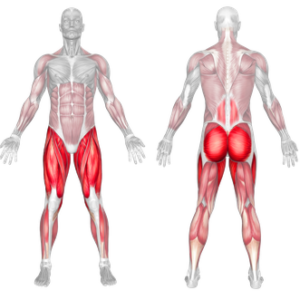
Frequently Asked Questions
Can I hold the dumbbell in different positions?
Yes. You can use a goblet hold at your chest or let the dumbbell hang between your legs. Choose what feels most stable for you.
What if my heels lift off the ground?
Try pointing your toes slightly less and widening your stance. You can also elevate your heels slightly for better ankle mobility.
Is this better than a sumo squat?
They are similar, but the plie squat emphasizes vertical torso positioning and adductor control more directly.
Can I do this with kettlebells?
Absolutely. A kettlebell held in a goblet or hanging position works just like a dumbbell and may be more comfortable for some lifters.

